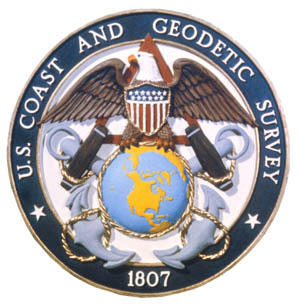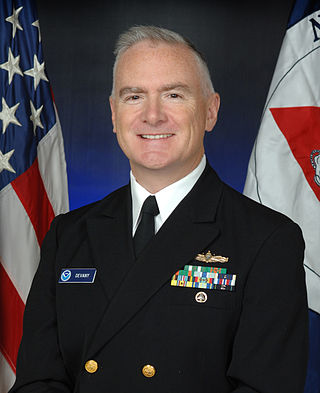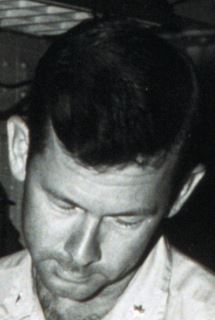
The National Oceanic and Atmospheric Administration is an American scientific and regulatory agency charged with forecasting weather, monitoring oceanic and atmospheric conditions, charting the seas, conducting deep-sea exploration, and managing fishing and protection of marine mammals and endangered species in the US exclusive economic zone. The agency is part of the United States Department of Commerce and is headquartered in Silver Spring, Maryland.
The United States has eight federal uniformed services that commission officers as defined by Title 10 and subsequently structured and organized by Titles 10, 14, 32, 33, and 42 of the U.S. Code.

The National Oceanic and Atmospheric Administration Commissioned Officer Corps is one of eight federal uniformed services of the United States, and operates under the National Oceanic and Atmospheric Administration (NOAA), a scientific agency overseen by the Department of Commerce. The NOAA Corps is made up of scientifically and technically trained officers. The NOAA Corps and the United States Public Health Service Commissioned Corps are the only U.S. uniformed services that consist only of commissioned officers, with no enlisted or warrant officer ranks. The NOAA Corps' primary mission is to monitor oceanic conditions, support major waterways, and monitor atmospheric conditions.

The Office of Marine and Aviation Operations (OMAO) is a division of the National Oceanic and Atmospheric Administration (NOAA) which operates a wide variety of specialized ships and aircraft to carry out the environmental and scientific missions of NOAA.

The Environmental Science Services Administration (ESSA) was a United States Federal executive agency created in 1965 as part of a reorganization of the United States Department of Commerce. Its mission was to unify and oversee the meteorological, climatological, hydrographic, and geodetic operations of the United States. It operated until 1970, when it was replaced by the new National Oceanic and Atmospheric Administration (NOAA).

USS Pathfinder (AGS-1) was a survey vessel for the United States Navy during World War II. Before and after the war she was USC&GSS Pathfinder (OSS-30) for the United States Coast and Geodetic Survey, named after the USC&GSS Pathfinder (1899-1941) that had surveyed and was lost in the Philippines at Corregidor. Pathfinder ended her service 23 December 1971 as she and the Coast and Geodetic Survey itself had come the National Ocean Survey under the National Oceanic and Atmospheric Administration (NOAA).

The United States Coast and Geodetic Survey was the first scientific agency of the United States Government. It existed from 1807 to 1970, and throughout its history was responsible for mapping and charting the coast of the United States, and later the coasts of U.S. territories. In 1871, it gained the additional responsibility of surveying the interior of the United States and geodesy became a more important part of its work, leading to it being renamed the U.S. Coast and Geodetic Survey in 1878.

Henry Arnold Karo was a vice admiral in the former United States Coast and Geodetic Survey Corps, which is today known as the National Oceanic and Atmospheric Administration Commissioned Officer Corps. Vice Admiral Karo spent most of his working career in the United States Coast and Geodetic Survey, which provided coastal maps and charts for the United States. He rose through the organization's bureaucracy to become the director of the Survey.

The National Oceanic and Atmospheric Administration Commissioned Officer Corps, one of the eight uniformed services of the United States, has the authority to issue various awards and commendations to its members. These include individual honor awards, unit honor awards, service awards, training ribbons and qualification insignia. NOAA Corps awards and decorations include:

Mount Nygren is an outstanding pointed mountain, bearing the aspect of a stark rock nunatak of pyramidal shape, which rises sharply above the middle of Hotine Glacier on Kyiv Peninsula in western Graham Land, Antarctica.

Michael S. Devany is a former vice admiral in the NOAA Commissioned Officer Corps who last served as the deputy under secretary for operations at the National Oceanic and Atmospheric Administration from January 2, 2014 to April 2016. He previously served as director of the NOAA Commissioned Officer Corps from August 13, 2012 to January 1, 2014, succeeding RADM Jonathan W. Bailey. As deputy under secretary for operations, he was NOAA’s chief operating officer. VADM Devany was responsible for the day-to-day management of NOAA’s national and international operations for oceanic and atmospheric services, research, and coastal and marine stewardship. He is a key advisor to the under secretary of commerce for oceans and atmosphere/NOAA administrator on NOAA program and policy issues. Devany was the first NOAA Corps officer to achieve the rank of vice admiral since VADM Henry A. Karo in 1965, and the second NOAA Corps officer overall. Devany retired from NOAA in April 2016 after over 30 years of combined uniformed service.

William L. Stubblefield, is a retired NOAA Commissioned Corps rear admiral. He served as the director of the NOAA Commissioned Corps from 1995 to 1999.

Rear Admiral Leo Otis Colbert was the third director of the United States Coast and Geodetic Survey and a career officer in the United States Coast and Geodetic Survey Corps, predecessor of the National Oceanic and Atmospheric Administration Commissioned Officer Corps.

Rear Admiral James C. Tison Jr. was an officer in the United States Coast and Geodetic Survey Corps and Environmental Science Services Administration Corps, both predecessors of the National Oceanic and Atmospheric Administration Commissioned Officer Corps. He served simultaneously as the first Director of the ESSA Corps, one of only two people to hold the position, and as the sixth Director of the United States Coast and Geodetic Survey.

Rear Admiral Don A. Jones was an officer in the United States Coast and Geodetic Survey Corps, its successor, the Environmental Science Services Administration Corps, and the ESSA Corps's successor, the National Oceanic and Atmospheric Administration Commissioned Officer Corps. He served simultaneously as the second and last Director of the ESSA Corps, one of only two people to hold the position, and as the seventh and last Director of the United States Coast and Geodetic Survey.

Rear Admiral Harley Dean Nygren was an American military officer who served in the United States Coast and Geodetic Survey Corps, its successor, the Environmental Science Services Administration Corps, and the ESSA Corps's successor, the National Oceanic and Atmospheric Administration Commissioned Officer Corps. He served as the first Director of the NOAA Corps.

Rear Admiral Kelly E. Taggart was a career officer who served in the United States Coast and Geodetic Survey Corps, its successor, the Environmental Science Services Administration Corps, and the ESSA Corps's successor, the National Oceanic and Atmospheric Administration Commissioned Officer Corps. He served as the second Director of the NOAA Corps.

Rear Admiral Francis D. "Bill" Moran is a retired career officer who served in the United States Coast and Geodetic Survey Corps, its successor, the Environmental Science Services Administration Corps, and the ESSA Corps's successor, the National Oceanic and Atmospheric Administration Commissioned Officer Corps. He served as the third Director of the NOAA Corps.

Richard Thomas Brennan, Jr. was a rear admiral in the NOAA Commissioned Officer Corps where he served as the 31st director of the Office of Coast Survey, replacing Shepard Smith. He also commanded NOAA Ship Rainier and NOAA Ship Rude.

Samuel P. Debow, Jr., is a retired rear admiral of the National Oceanic and Atmospheric Administration (NOAA) Commissioned Officer Corps who served as Director, NOAA Commissioned Officer Corps, and director, NOAA Office of Marine and Aviation Operations from 2003 to 2007.
















